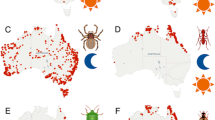Abstract
We studied the echolocation and foraging behavior of two Neotropical frugivorous leaf-nosed bats (Carollia perspicillata, C. castanea: Phyllostomidae) in a flight cage. To test which cues Carollia uses to detect, identify, and localize ripe Piper fruit, their preferred natural food, we conducted experiments under semi-natural conditions with ripe, unripe, and artifical fruits. We first offered the bats ripe fruits and documented their foraging behavior using multiflash stereophotography combined with simultaneous sound recordings. Both species showed a similar, stereotyped foraging pattern. In searchflight, the bats circled through the flight cage in search of a branch with ripe fruit. After finding such a branch, the bats switched to approach behavior, consisting of multiple exploration flights and the final approach when the bats picked up the fruit at its tip and tore it off in flight. Our behavioral experiments revealed that odor plays an important role in enabling Carollia to find ripe fruit. While foraging, Carollia always echolocated and produced multiharmonic, frequency-modulated (FM) signals of broad bandwidth, high frequency, short duration, and low intensity. We discriminated an orientation phase (mostly a single pulse per wingbeat) and an approach phase (groups of two to six pulses per wing beat). We conclude from the bats' behavioral reaction to real and artificial fruit as well as from characteristic patterns in their echolocation behavior that during exploration flights, Carollia changes from primarily odor-oriented detection and initial localization of ripe fruit to a primarily echo-oriented final localization of the position of the fruit.
Similar content being viewed by others
Author information
Authors and Affiliations
Additional information
Received: 27 March 1997 / Accepted after revision: 28 February 1998
Rights and permissions
About this article
Cite this article
Thies, W., Kalko, E. & Schnitzler, HU. The roles of echolocation and olfaction in two Neotropical fruit-eating bats, Carollia perspicillata and C. castanea, feeding on Piper . Behav Ecol Sociobiol 42, 397–409 (1998). https://doi.org/10.1007/s002650050454
Issue Date:
DOI: https://doi.org/10.1007/s002650050454




